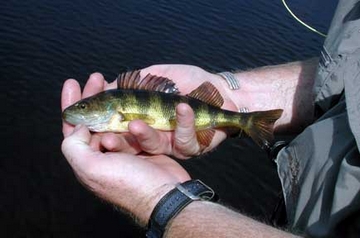The Perchposted on 8 February 2015 | posted in Hints and TipsLatin name: Perca fluviatilis Record weight: Five pounds nine ounces caught from a Kent pond in 1985 by Mr J. Shayler.  Distribution: Common in rivers lakes and ponds across Europe. Naturally found in England and introduced to Ireland, Scotland and Wales where it has now become widely established. A similar species - the yellow perch - is found in North America. Features: A handsome deep bodied fish with bright red fins and bold vertical stripes on a dark green background. The fins have strong leading rays, which form a row of sharp spines along the dorsal fin. The gill covers are also armoured with sharp edges that can draw blood if handled without care. The perch has the large eye and wide gape of an active hunter. Diet: The diet of most perch is made up of invertebrates. Small fish begin by feeding upon zooplankton, mainly cladocera, such as daphnia, before moving onto bloodworm and larger invertebrates as they grow. A small proportion of perch in each population begin feeding upon small fish when still very young. The fish that switch to a piscivorous diet grow much quicker than the others and are soon able to take larger fish in their diet. perch will take prey up to 60% of the width of their mouth, although they will attempt to feed upon much larger prey and can occasionally be caught on baits so large that they would not be able to swallow them. Spawning: Perch spawn in May and April in shallow marginal areas where the water is calm. This means wind sheltered bays in lakes and the backwaters of rivers. The perch lay their eggs upon submerged plants and snags. Unlike other species of coarse fish, perch lay their eggs in clumps and strings that are often washed up after storms. The eggs are easy to hatch in clean water and it is very interesting to watch the young fish develop in their protective shells. The young fish hatch in about 8-12 days after which they begin feeding after about another week. Growth: As mentioned above, perch are relatively slow growing fish that live for up to 12 years and reach sexual maturity at four years. These invertebrate feeders rarely weigh more than a pound in weight. Larger perch begin to grow quicker than their siblings from the age of about six months onwards. By the age of four these perch may be as much as two pounds in weight. In exceptional circumstances the perch will continue to grow rapidly for the whole of their lives. |








.jpg)
.jpg)





